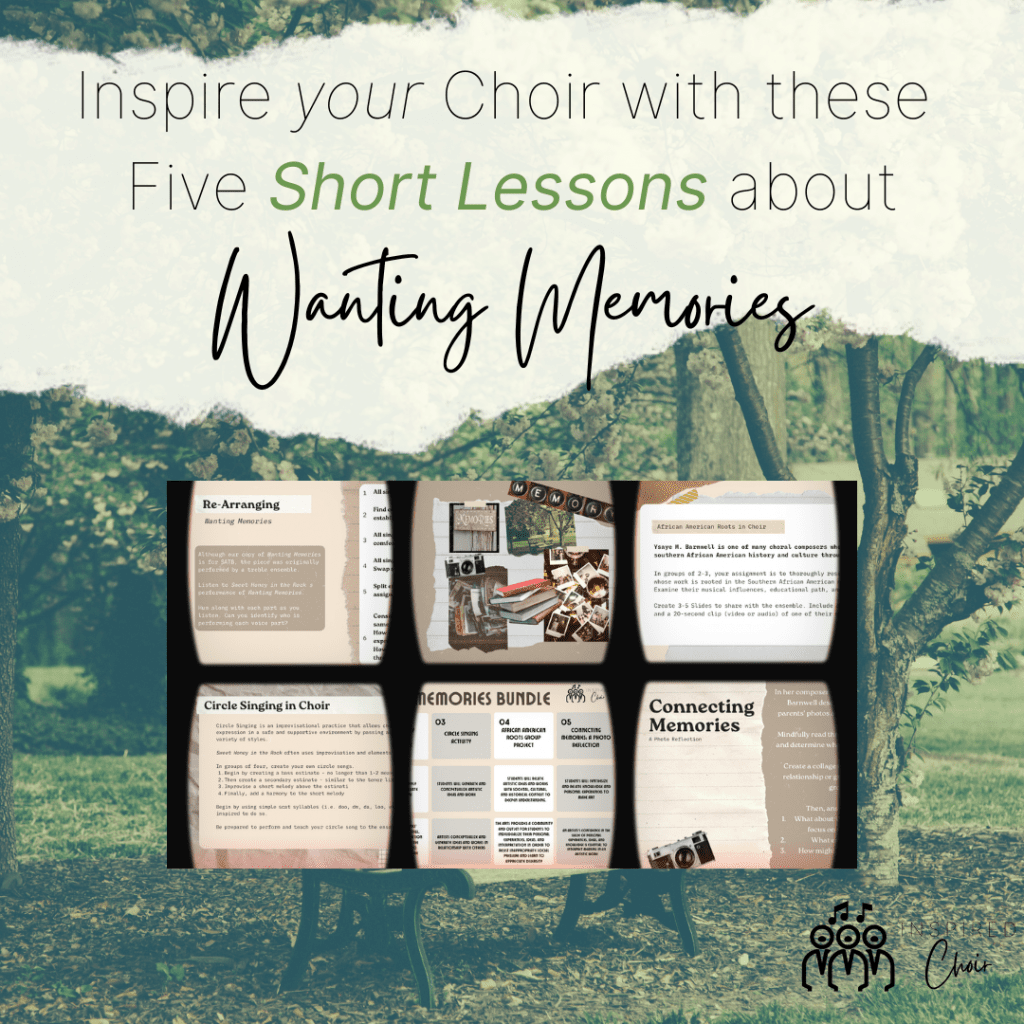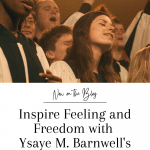Inspire Feeling and Freedom with Ysaye M. Barnwell’s Wanting Memories
Wanting Memories by Ysaye M. Barnwell is one of those pieces that gets in your ear and never leaves. The kind of song that makes you happy and somehow sad at the same time. With lyrics that make you want to call your best friend and tell them how much you love them. Take a listen to Sweet Honey in the Rock’s recording of Wanting Memories linked here and then dig into this post, in which I share the following:
- All About Composer Ysaye M. Barnwell
- Crossings: The Larger Work
- The Work of Sweet Honey in The Rock
- Wanting Memories Reflections and Conversations
- Arranging and Musical Concepts in Wanting Memories
- Wanting Memories Teacher Resources
- …and so much more!

Some of the links below are affiliate links. This means that, at zero additional cost to you, I will earn an affiliate commission if you click through the link and finalize a purchase.
Behind the Scenes of Wanting Memories
With a simple ostinato, thought-provoking text, and comforting harmonies, Ysaye M. Barnwell’s Wanting Memories is a beautiful addition to any choral program. Learning this piece cannot be complete, however, without an understanding of its roots, creation, and intent. Below, I describe these ideas and share my plan for re-arranging the piece with my treble ensemble.
Featured Composer: Ysaye M. Barnwell
A multi-faceted musician and professional, Dr. Ysaye M. Barnwell is a speech pathologist, professor, violinist, vocalist, sign language interpreter, voice-over actress, children’s book author, master teacher, choral clinician, and composer. As a member of the vocal group Sweet Honey in the Rock from 1979-2013, Barnwell has shared her experience and understanding of singing in the African American Tradition and modeled her pedagogy for numerous educators.
Barnwell’s work has been commissioned for a variety of projects nationally, and much of her work is dimensional including film, video, dance, and choir. Below are a few examples of these works:
- Fortune’s Bones: The Manumission Requiem: Poet-laureate Marilyn Nelson’s book-length poem about Fortune, an enslaved African American who was a doctor in post-colonial Connecticut, is transformed by Barnwell into a cantata performed by symphony, choirs, soloists, and a chorus of African bells. The project celebrates the “fullness of African American life” and “metaphorically set Fortune’s bones to rest.”
- No Mirrors in My Nana’s House: Arranged for SATB ensemble here, this piece shares the story of a young girl who finds beauty not by looking in the mirror, but by looking in her Nana’s eyes. Also available as a children’s book illustrated Synthia Saint James.
- We Are: The final section of Lessons, an unaccompanied suite of songs for mixed chorus: “For each child that’s born, a morning star rises and sings to the universe who we are.”
The composer is passionate about education and community music-making as powerful ways to address social injustice. By understanding the historical roots of the African American musical tradition, Barnwell believes that people can then understand how music “is the glue that holds communities together.”
Crossings – The Larger Work
Wanting Memories is one of five sections in the 30 minute song suite called Crossings. Originally composed for a dance theater work with narration, the suite for mixed chorus includes an overture, No Mirrors in My Nana’s House (described above), Lost In Blue, Wanting Memories, and When I Die.
These five pieces, combined with dance and spoken word, share a coming-of-age story of an individual confronting racism in their community as they grow up. The work highlights the importance of empowerment and cultivating beauty in our views of self and community.
This performance of Wanting Memories by the Choral Chameleon Chorus includes theatrical elements and movement. As we learn this work, my ensemble and I will consider the use of movement and poetry in addition to our vocal performance.
Does anyone have a recording of a full performance of the larger work? Or a list of the poetry used? These resources would definitely be helpful – let me know in the comments below!

Sweet Honey in the Rock
Formed in 1973, the vocal group and ambassadorial African American organization Sweet Honey in the Rock has been performing and singing worldwide for four decades. The ensemble was founded by Bernice Johnson Reagon and named for Psalm 81:16, a verse which speaks of land so rich that when rocks are cracked open, honey flows from them.
With the goals of empowerment, education, and entertainment, 20 singers have sung with the Grammy nominated female a cappella vocal group over time. The current members are Nitanju Bolade Casel, Aisha Kahlil, Carol Maillard, and Louise Robinson.
Known for their theatrical performances and socially conscious messages, the ensemble has shaped their sound to include a cappella, world, gospel, and folk roots. The most recent iteration of the group additionally blends elements of hip hop, jazz, and R&B into their sound. Their most recent album, #LoveInEvolution, released in 2016, was the group’s 27th recording.
As a group, the ensemble develops new material through improvisational work and largely composes for themselves. In this capacity, from 1979-2013, Ysaye M. Barnwell sang, composed, and sign language interpreted for Sweet Honey in the Rock.
What does it mean to be Wanting Memories?
Barnwell composed Wanting Memories specifically for the dance theater piece Crossings. She dedicated the piece to her father, who at the time was still living. In her composer’s notes for the piece, Barnwell explains that when her parents died and she prepared to sell their house, she found bags of memorabilia like photos and letters, realizing her unconscious wish of Wanting Memories.
SEL-INspired Conversations
When diving in to discussions with young singers, especially, I like to frame our conversations with the Social Emotional Learning Competencies. (I talked a bit about SEL here and here.) Below are a few discussion starters for Wanting Memories:
| SEL Competency: | Discussion Prompts: |
|---|---|
| Self-Awareness | Can you identify with the speaker of this song as they “want memories” and need someone who is gone? How do you feel in those moments? What emotions do you have as you consider “wanting memories?” |
| Self-Management | The speaker of this piece reflects on stories they were told and happy memories from the past to work through their grief. What strategies do you have to manage when the world feels like a “cold and bitter place”? |
| Decision Making | As you sing Wanting Memories, what musical decisions can you make to share with your audience the emotions associated with each verse and chorus of this piece? |
| Social Awareness | How do you know when someone else is experiencing sad or reflective moments? What visual or verbal cues help you to know and understand where they are in their grief? |
| Relationship Skills | How might you support a friend or colleague who is experiencing a loss or grieving? What actions or conversations might you have to encourage them as they process? |
If you want to know more about Social Emotional Learning, I encourage you to check out the books linked below. These are some of my favorites!

Arranging and Musical Concepts:
I came to know Wanting Memories when I was teaching choir at a high school in Illinois and it was an All-State piece for my students. Although arranged for SATB, Wanting Memories was programmed as the treble piece for the concert. When my students performed it back then, they received a list of instructions for re-arranging the piece that I no longer have.
I could probably dig around and find the instructions, but I think it would be better for my treble ensemble to work through the arrangement this fall and find a solution themselves. Here is the outline I plan to follow for our creative process:
- Teach bass line by rote in an accessible range during warm-ups, add tenor ostinato
- Listen to recording of Sweet Honey in the Rock’s performance, hum along with part of choosing
- All students sing melody, soprano, and alto line of refrain
- Add bass and tenor, allowing students to cycle through different voice parts
- Try several configurations, allowing students to choose what part they want to sing
- Find a balance, standing arrangement, and ideal key
- Consider use of movement depending on singers’ comfort level
Moments like this allow the singers to experience creativity within an ensemble and work as a group to complete a common goal. We will be listening to the recording often as rote learning is an essential element of the African American singing tradition.
Sometimes it’s a little bit easier to grasp on to music theory concepts when you see them in context. Here are a few musical concepts you may come across as you study this piece:
- ostinato – a musical figure repeated at the same pitch throughout a composition; Italian for obstinate or persistent (as seen in the bass and tenor lines)
- ledger lines – short lines added for reading notes above or below the staff
- dotted rhythms – rhythms using longer notes alternating with shorter notes, as utilized often in swing music. A dot written after a note adds one half of the note’s value to the original note’s value.
- vocal percussion – creating sounds with one’s mouth that imitate a percussion instrument (as seen in the tenor line that imitates a shaker)
Complimentary Pieces
Want to listen to other pieces like Wanting Memories? Or planning a concert and need some programming ideas? Here are a few complementary pieces!
Want to explore more choral music with Black Southern Roots?
- Check out Luther College Cathedral Choir’s performance of Undine Smith Moore’s “We Shall Walk in the Valley of Peace.” Stunning.
- NDSU Concert Choir’s performance of Joseph Jennings “Keep Your Hand on the Plow” is a great listen.
- Rosephanye Powell’s “Keep Yo’ Lamps” is an excellent teaching piece with openings for discussion and varied interpretations.
- Additional Resources: Blake Morgan’s list of 31 Black Choral Composers and Marques L. A. Garrett’s research on Non-Idiomatic Choral Music of Black Composers
A few of the other “roots” themed pieces I’m pairing with Wanting Memories this concert cycle:
- Reena Esmail’s TāReKiTa
- Hart Rouge’s Vichten
- Susan Labarr’s The River
- Miriam Sonstenes’s I Am Leaving

I’d Love to Hear from You!
Have you sung or conducted Wanting Memories with your choir? What memories does the piece evoke for you? What connections have you drawn to Sweet Honey in the Rock and the larger work Crossings? Let me know in the comments section below!
Wanting Memories Teacher Resources
Free Comprehension Worksheets
Choir Leaders! I have begun to include short comprehension worksheets with each Inspired Choir blog post. Each worksheet includes 5-6 knowledge-based questions about the post and concludes with a musical decisions/applications question. Use as a homework assignment, sub activity, listening challenge, or guide for conversation in class. Fill in the form below to receive a link immediately to all “Roots” Worksheets.
Wanting Memories Lesson Plan Bundle
Check out the Inspired Choir Shop for the Wanting Memories Lesson Plan Bundle. This bundle includes the following five minute lesson plans, all with connections to National Standards and SEL Competencies:
- Re-arranging Wanting Memories Prompts
- Sweet Honey Listening Assignment
- Circle Singing Activity
- African American Roots Group Project
- Connecting Memories: A Photo Reflection
























